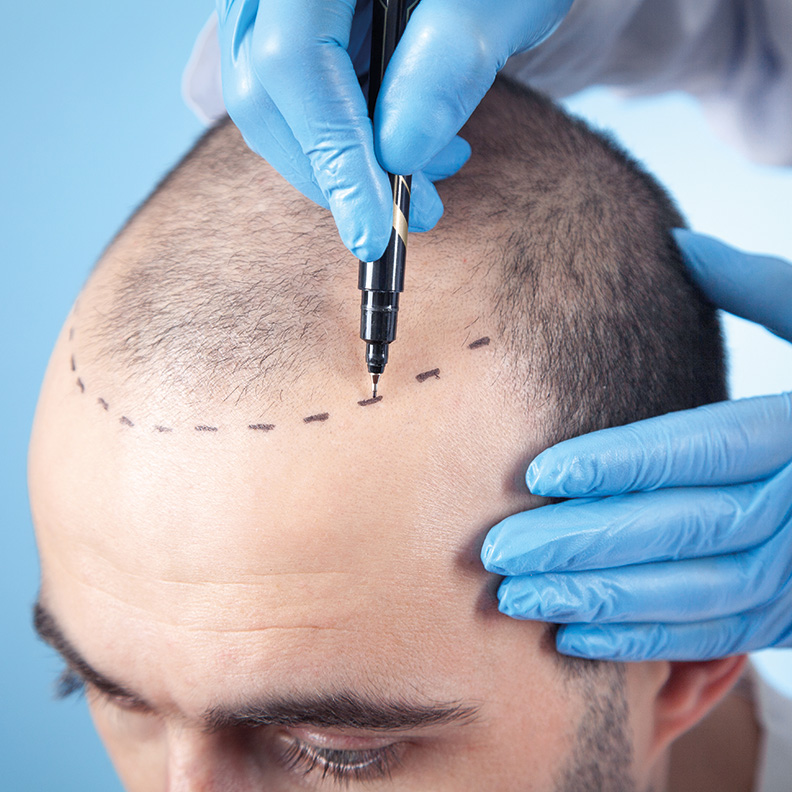
Hair transplant is a popular treatment for people who suffer from hair loss or baldness. It is a procedure that helps restore natural-looking hair in areas where hair has become thin or completely gone. This treatment is suitable for both men and women who are Hair transplant hair thinning due to age, genetics, hormonal changes, or medical conditions.
What Is a Hair Transplant?
Hair transplant is a surgical method in which hair follicles are taken from one part of the body, usually the back or sides of the scalp, and then transplanted into the areas where hair growth is needed. This process is designed to create a natural and long-lasting solution for hair loss.
There are mainly two types of hair transplant techniques: Follicular Unit Transplantation (FUT) and Follicular Unit Extraction (FUE). Both methods are effective, but the choice depends on the patient’s hair condition, preference, and the doctor’s recommendation.
Reasons for Hair Loss
Hair loss can happen due to many reasons. Some of the common causes include:
-
Genetic hair loss
-
Hormonal imbalance
-
Aging
-
Stress or anxiety
-
Nutritional deficiencies
-
Use of harsh hair products
-
Scalp infections
-
Medical treatments like chemotherapy
Understanding the root cause of hair loss is important before selecting the right hair restoration treatment.
Who Can Get a Hair Transplant?
Hair transplant is a good option for people who have lost hair due to permanent reasons such as male pattern baldness or hair thinning that does not grow back on its own. However, not everyone is a suitable candidate. The ideal candidate is someone who:
-
Is in good general health
-
Has enough donor hair on the scalp
-
Has realistic expectations from the procedure
-
Has permanent hair loss
People with temporary hair loss, poor scalp health, or medical conditions that affect healing may not be ideal candidates for the procedure.
Hair Transplant Procedure
The procedure begins with a consultation where the hair specialist examines the scalp and discusses the expectations. Once the plan is finalized, the procedure takes place in the clinic. It generally involves the following steps:
-
Preparation: The scalp is cleaned, and anesthesia is given.
-
Donor Area Selection: Hair follicles are extracted from the donor area.
-
Graft Collection: In FUT, a strip of skin is removed, while in FUE, individual follicles are taken.
-
Recipient Site Creation: Tiny cuts or holes are made in the area where hair is to be transplanted.
-
Implantation: The harvested grafts are carefully placed in the recipient area.
-
Recovery: The healing process begins, and new hair starts to grow in a few months.
The process can take a few hours to a full day, depending on the number of grafts required.
Recovery After Hair Transplant
Recovery from a hair transplant is generally simple. Most people can return to work within a few days. However, it is important to follow aftercare instructions provided by the clinic. Some tips include:
-
Avoid washing the scalp for the first few days
-
Do not scratch or rub the scalp
-
Sleep with the head elevated
-
Avoid heavy exercise for a few weeks
-
Use only prescribed shampoo and medications
The transplanted hair may fall out within the first few weeks, which is normal. New hair growth begins in about three to four months and continues to improve over time.
Results of Hair Transplant
Hair transplant results are usually permanent. The transplanted hair behaves like natural hair and continues to grow. It may take 6 to 12 months to see full results. The success of the procedure depends on the skill of the surgeon, the quality of donor hair, and how well the patient follows post-procedure care.
The results can greatly improve self-confidence, appearance, and overall quality of life for people who struggle with baldness or hair thinning.
Advantages of Hair Transplant
There are many benefits of getting a hair transplant:
-
Natural hair growth
-
Permanent solution for hair loss
-
Improved appearance
-
Boost in confidence
-
Low maintenance after recovery
-
No need for wigs or hairpieces
Hair transplant is a one-time investment that offers long-term results when done properly.
Possible Side Effects
While hair transplant is a safe procedure, some minor side effects can occur, such as:
-
Swelling of the scalp
-
Bleeding or scabbing
-
Temporary hair shedding
-
Infection (in rare cases)
-
Itching or redness
These effects are usually mild and temporary. Choosing a qualified and experienced hair specialist reduces the risk of complications.
Cost of Hair Transplant
The cost of a hair transplant can vary depending on the number of grafts required, the method used, and the expertise of the surgeon. It also depends on the clinic and location. Some clinics offer payment plans to make the treatment more affordable.
It is important to remember that the cheapest option is not always the best. Quality care and experienced professionals should always be a priority when choosing a clinic.
Choosing the Right Clinic
Selecting the right clinic is one of the most important steps in getting a hair transplant. A good clinic will have:
-
Skilled and experienced doctors
-
Proper hygiene and safety standards
-
Transparent pricing
-
Good patient reviews
-
Aftercare support
It is recommended to have a detailed consultation before starting the treatment to understand the procedure, risks, and results.
Final Thoughts
Hair transplant is a reliable and effective solution for people facing permanent hair loss. It offers a natural look and helps people regain confidence. With proper planning, expert guidance, and post-treatment care, hair transplant can bring great improvement in appearance.
If you are thinking about getting a hair transplant, consult a trusted clinic like Hash Clinics for professional advice and treatment.
Comments on “Effective Hair Transplant Solutions for Hair Loss and Baldness”